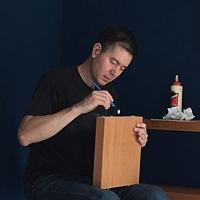Share your craft projects
Make new craft buddies
Ask craft questions
Blog your craft journey

[01.06 Folding Work Table - Top and Support Structure.jpg]
The tabletop is just a 1/4" plywood panel with a 2” wide sassafras frame. The frame ...
[01.06 Folding Work Table - Top and Support Structure.jpg]
Before I started assembling the support structure, I cut 10-degree bevels on the bott...
The heart of the table is a support structure for the thin plywood top, and the heart of the support structure is a lattice of I-beams. Each I-beam...
This is the start of a blog series on my Folding Work Table and Storage Bracket project.
I’ll preface this section by repeating that, for the mos...
[13.03 Fixes - Base Weight Rebar in Base.jpg]
When I brought the assembled rack inside, I was pleased to see that it was quite stable when the...
[12.13 - Finish and Assembly - Finished Rack.jpg]
With the brace finished, the rack was almost ready to assemble. I started by adding the top cap...
[02.07 Design - Cart Details.jpg]
The support brace is a large open triangle that connects the cart’s base and rear panel. The top of the brace ...
[02.07 Design - Cart Details.jpg]
With the washers sorted, I started on the cart’s base. The base is a panel with a skirt, an upside-down, open b...
Before I started working on the cart, I decided it was time to address a problem I had been deferring. The racks pivot on 3/8” dowels, with a washe...
[02.06 Design - Rack Details.jpg]
In preparation for assembling the racks, I prefinished their interior sides (no pictures of that) along with the...
[07.00 Magnets - Rendering.jpg]
With the spool blocks and tilt stops shaped and sanded, it was time to start thinking about the magnets that woul...
[02.02 Design - Spool and Bobbin Blocks.jpg]
When I last worked on the spool blocks in Part 2: Starting on the Spool Blocks, they had rectangul...




















